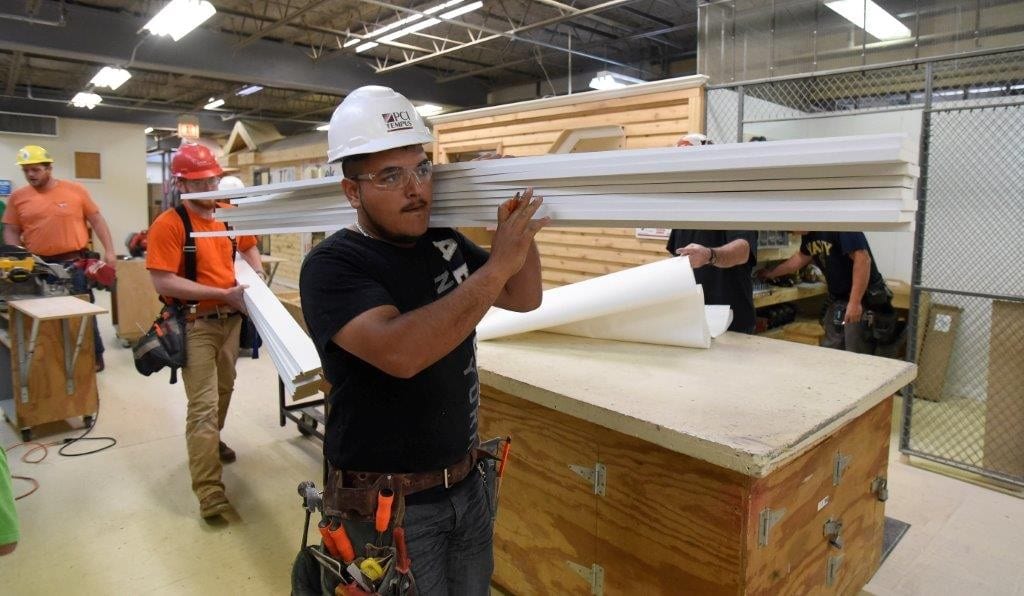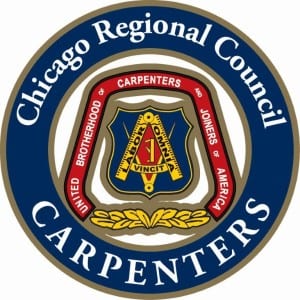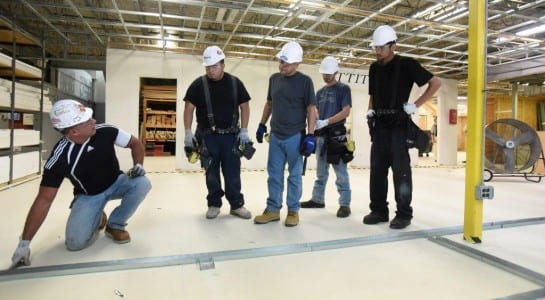It is Training That Sets Chicago Regional Council Carpenters Apart from the Competition
With the economic recession thankfully becoming more of a distant memory and as the Chicagoland construction market has picked up steam, the Chicago Regional Council of Carpenters (CRCC) has been one step ahead in preparation for current and projected growth. With each passing day the Carpenter Training Center is producing new and advanced skilled tradespeople who are ready, willing and able to meet not only construction industry labor demands, but the needs of the communities in which we all live. Here is why.
The depth and breadth of training courses offered to members empowers them to seize a career and bring the requisite standard of excellence to Chicagoland projects and job sites.
 “In the 30-plus years that I’ve been in the trade show industry as a labor contractor, show organizer and association manager I have long known that our industry couldn’t exist without the service and support of a standby workforce to move our shows in and out of the nation’s convention centers,” said Executive Director Jim Wurm of the Exhibit & Event Marketers Association. “I’ve also been highly aware that one of the great challenges our industry has is the competency and levels of service excellence vary greatly from venue to venue and city to city. It is clear to me and to most experienced trade show professionals that the carpenters in Chicago are the cream of the crop. Their attitude, work ethic and skill sets clearly are the best in our business. The EAC members of the E2MA frequently tell me that their ability to serve their customers would be greatly enhanced, if all trade show locals were as professional and proficient as the Chicago carpenters. In my view the combination of a world class venue (McCormick Place) and the industry’s best workforce clearly make Chicago the top choice for our industry’s premier events.”
“In the 30-plus years that I’ve been in the trade show industry as a labor contractor, show organizer and association manager I have long known that our industry couldn’t exist without the service and support of a standby workforce to move our shows in and out of the nation’s convention centers,” said Executive Director Jim Wurm of the Exhibit & Event Marketers Association. “I’ve also been highly aware that one of the great challenges our industry has is the competency and levels of service excellence vary greatly from venue to venue and city to city. It is clear to me and to most experienced trade show professionals that the carpenters in Chicago are the cream of the crop. Their attitude, work ethic and skill sets clearly are the best in our business. The EAC members of the E2MA frequently tell me that their ability to serve their customers would be greatly enhanced, if all trade show locals were as professional and proficient as the Chicago carpenters. In my view the combination of a world class venue (McCormick Place) and the industry’s best workforce clearly make Chicago the top choice for our industry’s premier events.”
“Our extensive training program and apprenticeship program are what sets union carpenters apart from nonunion carpenters,” said Regional Council Training Director Vince Sticca. “Our members have access to incredible training and continuing education that keeps their skills sharp and their minds equally sharp to be able to successfully operate and manage the latest technology and materials on project sites. There is no similar program or facility for nonunion carpenters.”
Ultimately, it is the commitment and investment from the Chicago Regional Council of Carpenters and President Frank Libby, the CRCC’s trustees and signatory contractors, and the school’s dedicated instructors and staff who form the bedrock of this program’s success for now and the future.
To be a carpenter means to be identified with one of the oldest and most respected trades. While the public often thinks of a carpenter as a man or woman who focuses solely on working with wood, this is far from a complete definition. The Chicago Regional Council of Carpenters (CRCC) provides the construction, trade show and maintenance industries with productive, competitive, certified professionals to meet a broad range of societal needs and bring ease and efficiency to our everyday lives.
 The CRCC’s carpenters and millwrights possess the versatility and skill to build critical transportation infrastructure (roads, bridges, rail, sea walls, deep tunnel projects and pump stations); construct both major residential and commercial projects from the concrete to the finished trim work, locks and closures; address the sustainability and energy market through Building Renewable Resource Projects sm; install and maintain machinery and equipment within industrial plants throughout our jurisdiction; erect Chicago’s high-rises and skylines to the region’s municipal buildings and service facilities; and much more. The CRCC puts its diverse skills to work across the Midwest on: houses, apartments and condos; skyscrapers, schools and office buildings; health care facilities, assisted living centers and houses of worship; bridges, railways, tunnels and highways; trade shows at McCormick Place, the Rosemont Convention Center, Navy Pier, hotels and conference centers; generators, electrical and wind turbines, nuclear power plants and refineries; floorcovering including carpet, wood and vinyl products; mill cabinet industry; charitable endeavors like home renovations for the needy and aid in times of community crises.
The CRCC’s carpenters and millwrights possess the versatility and skill to build critical transportation infrastructure (roads, bridges, rail, sea walls, deep tunnel projects and pump stations); construct both major residential and commercial projects from the concrete to the finished trim work, locks and closures; address the sustainability and energy market through Building Renewable Resource Projects sm; install and maintain machinery and equipment within industrial plants throughout our jurisdiction; erect Chicago’s high-rises and skylines to the region’s municipal buildings and service facilities; and much more. The CRCC puts its diverse skills to work across the Midwest on: houses, apartments and condos; skyscrapers, schools and office buildings; health care facilities, assisted living centers and houses of worship; bridges, railways, tunnels and highways; trade shows at McCormick Place, the Rosemont Convention Center, Navy Pier, hotels and conference centers; generators, electrical and wind turbines, nuclear power plants and refineries; floorcovering including carpet, wood and vinyl products; mill cabinet industry; charitable endeavors like home renovations for the needy and aid in times of community crises.
The professional construction industry overall generally recognizes that skilled union tradespeople are more productive, effective and efficient than those who have not been union trained, translating to increased profitability for the firms that hire them.
“I have been in the trade show industry for 33 years and have worked with every local labor force around the country” said Owner/President Steve Johnson of Renaissance Management. “In my opinion the Chicago Carpenters are the best of the best. Working in McCormick Place and in the greater Chicago area has always been a pleasure due to the tremendous attitude, work ethic and skill of these people. When I broke into the business in the early 80s we used to refer to our crew as “The lunch pail gang,” as they came to work every day ready to give a strong eight hours of work for the pay they would receive. Recent changes in the work rules have enabled this group to offer higher levels of service and efficiency to exhibitors which allows Chicago to continue to attract the highest quality events in the nation.”
In fact, a series of studies conducted by Steven G. Allen, professor of economics at North Carolina State University, supported this fact when it found that contractors that use organized labor are 35 to 50 percent more productive than those that don’t. While a small group of builders and developers within the construction industry like to claim that there are not enough skilled carpenters and tradespeople to go around, this claim is misleading and made at the expense of the working class, driving down worker wages, debilitating families and destabilizing communities.
“An educated, productive, motivated workforce will more than counterbalance the higher labor costs associated with a union partnership,” explained Chicago Regional Council of Carpenters President/Executive Secretary-Treasurer Frank Libby. “The net effect is that a company that hires union labor can improve its bottom line and it can improve its employee productivity with less employee turnover. Employees who are paid a fair wage and have insurance benefits, access to continuing education and can retire with dignity are people who have chosen to make a career in this industry. The most qualified tradespeople tend to migrate toward the best benefits, seeking the highest level of security, job-site safety and wages.”
“Within our partnership we can provide this at a cost that no firm can ever match on its own,” Libby continued. “Partnering with us allows companies to retain the most productive and efficient workforce, get the best value for their money, reduce health care and pension costs through hour multiemployer programs and reduce the incidence of job-site accidents (which, in turn, reduces worker compensation and liability insurance costs and minimizes Occupational Safety and Health Administration [OSHA] citations).“
The CRCC has the most efficient safety program of any council in the brotherhood,” Libby added. “This safety program was founded in 1979 and has been designed to assist in protecting our members from sustaining job-site fatalities and injuries and also help our contractors to comply with state and federal OSHA standards.
The standards to which CRCC members hold themselves to, not only keep them safe on the job site, but ensure that all structures are safe, as well.
“Having worked with our clients in most, if not all, major convention centers across the United States my experience tells me that the Chicago Regional Council of Carpenters has always been up to the task,” said John “Jack” Patronski, Executive Vice President-Industry Development, Global Experience Specialists. “Whether it is a top 10 exhibition or a smaller event in a hotel facility they understand how to get the job completed. With the more flexible “exhibitor rights” that were agreed to in the fall of 2011 the Carpenters have been very cooperative in making this labor legislation a success and allowing exhibitors to do work they wish to perform on their own. In addition I have had the opportunity to serve on the MPEA Management Labor Council with Business Representative Kevin McLaughlin, and he is very active in working to identify additional ways to improve customer service for both show organizers and exhibitors.”
The CRCC recently launched the eXcellence in Training Recognition Award (XTRAsm) initiative, an incentive program designed to recognize and reward carpenters who take advantage of the training, continuing education and certification classes that are offered at Carpenter Training Centers. “I cannot emphasize enough the importance of skill training and certifications for our journey-people,” said CRCC President Frank Libby. “The awards of this program are symbolic of effort and commitment, but the true benefit will be realized by the journeyperson on the job site, when he or she arrives for work and brings a new level of self-confidence to the project and added benefit to the employer,” Libby said.
The CRCC has also partnered with select Chicago and suburban junior colleges on a program that recognizes and rewards apprentice training by granting college credit hours, enabling accredited carpenters to earn an associate’s degree and opening the door to higher education for many who felt that a college degree was time or cost prohibitive.
Carpenter work is very physical and challenging,” Sticca continued. “You are generally working in the weather extremes of the Midwest, and you are often carrying heavy materials and working on scaffolds. Work also involves math, dexterity and hand-eye coordination. So you have to be willing and able to do all of that.
“While students are with us at the training centers we make sure that they are well-rounded, well-educated and safe. When you are a carpenter, in order to advance your career you need to know how to do many things, from trim work to foundations to constructing interior systems using metal studs, so we teach all of that and more,” Sticca stated. “And we stress teamwork. Carpenters need to be able to work as part of a team. They also need to be able to use the latest technology and install the newest materials, so that is why we emphasize continuing education to our journeyperson members.”
It is society as a whole that stands to win when proficiency, experience and productivity merge with commitment and desire. That defines the working class of the Chicago Regional Council of Carpenters—A Positive Force in Building Communitiessm.
This article was aurthored by Exhibit City News. For more information about the CRCC training programs, visit www.chicap.org or call 847-640-7373.







